Thai green papaya salad or som tum is one of my most popular recipes, but that recipe is actually a type of papaya salad that we call som tum thai or Thai style papaya salad. There are other types of papaya salad in Thailand, and one that is arguably just as popular is called som tum pla ra or som tum lao (Lao style papaya salad). So if you’re a fan of deeply umami flavour and a bit of funk, this style is the one for you. It is just as easy to make and is a guaranteed crowd pleaser.
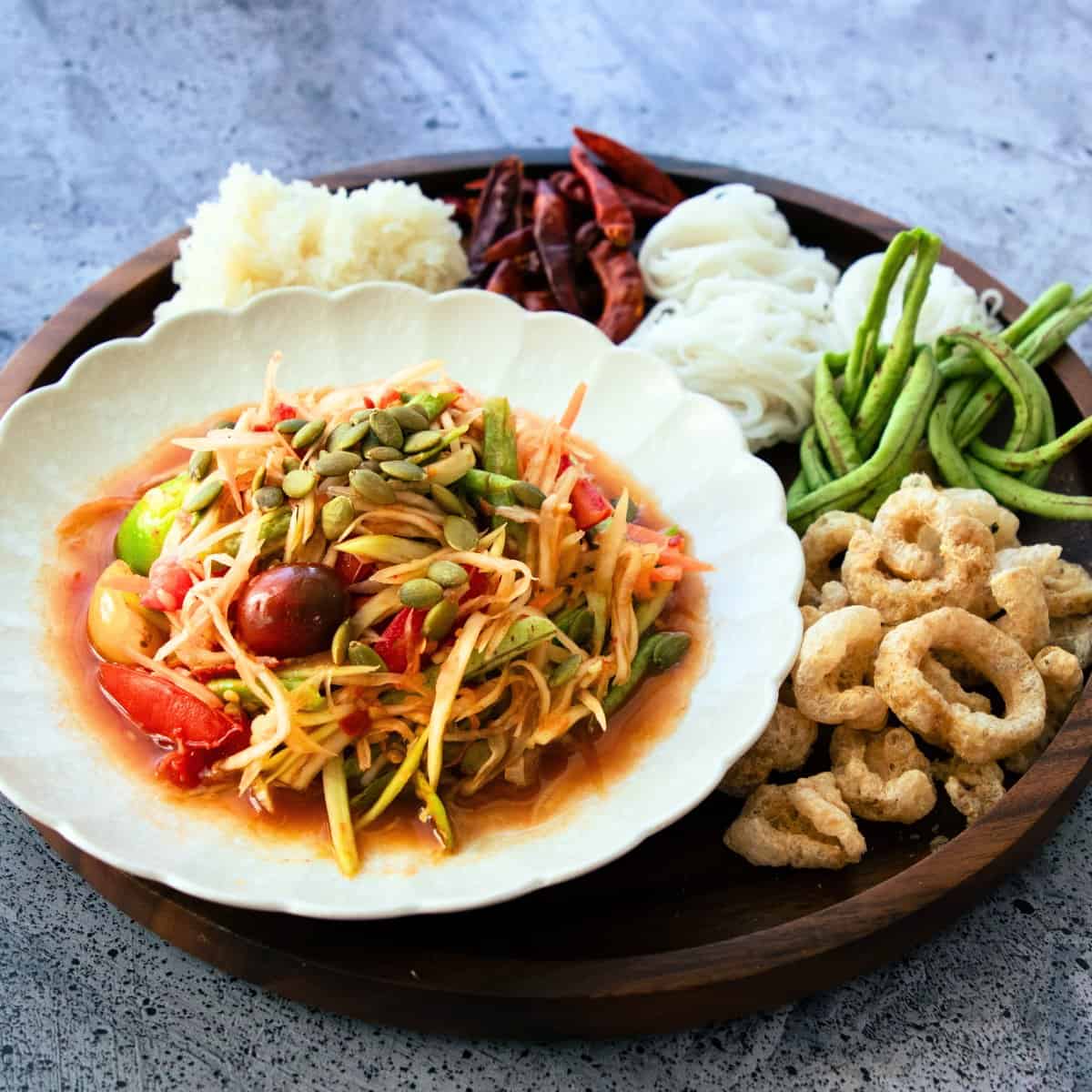
But first, to be clear, this recipe is not a Lao papaya salad. It is a Thai papaya salad, but we call it "Lao style" because it uses a fermented fish sauce that's commonly used in Lao papaya salads (more on this below). While there are many overlaps between Lao and Northeastern Thai cuisine, the papaya salads made in Laos can be different from what we have in Thailand.
What is Som Tum? And What is Som Tum Pla Ra?
Som tum is the generic term for pounded salads that are made in a mortar and pestle. You can make som tum using many ingredients, but the original one is made using green papaya, which is simply the underripe version of an orange papaya.
In most Thai restaurants overseas, there is only one type of papaya salad on the menu, and that is typically a Thai style papaya salad or som tum thai. But in Thailand, we have many kinds of papaya salads, and one very popular kind is som tum pla ra - a.k.a. som tum lao. It's so named because it uses pla ra, a fermented fish sauce that is commonly used in Laos, hence its alternate name. You can read a lot more on this ingredient below!
Compared to Thai style papaya salad, som tum pla ra does not use dried shrimp, peanuts, and tends to be less sweet.
Ingredients & Notes
Here are all the ingredients you need and some important notes about them. For amounts see the recipe card below.
- Garlic
- Thai chilies, fresh or dried. Add as many as you like depending on your heat tolerance. Some people prefer fresh chilies, others prefer dried, so it really doesn’t matter which you choose and you can even do both. Arbol chilies are a great dried chili option for som tum. If you prefer it milder, instead of adding less chilies I recommend removing the seeds and pith so you keep the chili flavour in the salad.
- Palm sugar. Finely chop the sugar so that it will dissolve readily, especially if you do not have a mortar and pestle for making the salad. If you don’t have palm sugar, light brown sugar will work as a substitute.
- Long beans. These are optional for tum lao though I quite like the flavour and colour that they add. If omitting, you can simply add more papaya or carrots, or you can substitute blanched green beans. Note: Long beans can be eaten raw but green beans cannot, so make sure you give green beans a quick 1-min blanch in boiling water, then shock them in ice water so they remain crisp.
- Tomatoes. You can use regular tomatoes cut into wedges, or grape or cherry tomatoes cut in half.
- Fresh lime juice. Emphasis on fresh as it makes for the best flavour, and we also need the skin to add some extra aroma!
- Tamarind paste this is a sour seasoning that is optional, but I like the complexity that it adds to the salad. If not using, you can substitute more lime juice. You can buy tamarind paste premade, but I prefer making it from pulp. You can read more about tamarind here, and if you want to make your own, here's my homemade tamarind paste recipe.
- Pla ra fermented fish sauce. This is the identifying ingredient, without which you cannot make this recipe! More on this below.
- MSG (optional), I never call specifically for MSG, but for this style of papaya salad it is usually added. So if you want your salad to taste like it does in northeastern Thailand, then a little pinch is recommended 🙂.
- Julienned green papaya. Green papaya is an unripe papaya that has a crisp, firm, and neutral-flavored flesh. Choose the type that is large (not the small Hawaiian ones) sold at many Asian grocery stores. Don’t have papaya? Read about papaya substitutes below.
- Julienned carrots. This is optional, but a handful of julienned carrots adds a pop of colour that makes this salad much prettier!
- Pumpkin seeds, toasted. I am using these as a sub for kratin seeds, which are seeds of the river tamarind plant. They look similar to pumpkin seeds, and both add a nuttiness to the salad.
- For serving:
- Sticky rice is a classic accompaniment.
- Crispy pork rind (store bought) add a nice fatty crunch.
- Vietnamese style rice vermicelli (kanom jeen) is amazing with this. You can serve them on the side or mix a small bundle right into the salad. Note: Vietnamese rice vermicelli are the round, slightly thicker noodles like ones I use in my kanom jeen namya recipe, whereas Thai rice vermicelli are the super thread-thin Thai ones.
How to Make Som Tum With and Without a Mortar and Pestle
The word "tum" in som tum means to pound, which is the technique of pounding ingredients in a mortar and pestle. But don't worry if you don't have a mortar and pestle, or if you only have a small one; below I show you 2 different ways to make som tum, with and without the mortar and pestle.
*If you have a mortar and pestle but it is too small for the salad, simply do everything in your M&P right up until it's time to add the papaya, then transfer into a mixing bowl and switch to the hand method.
But first...you have to julienne the papaya
Here are 3 different ways to julienne green papaya. The julienning techniques are much easier understood by video, so I recommend watching the video tutorial if you've never done it before!
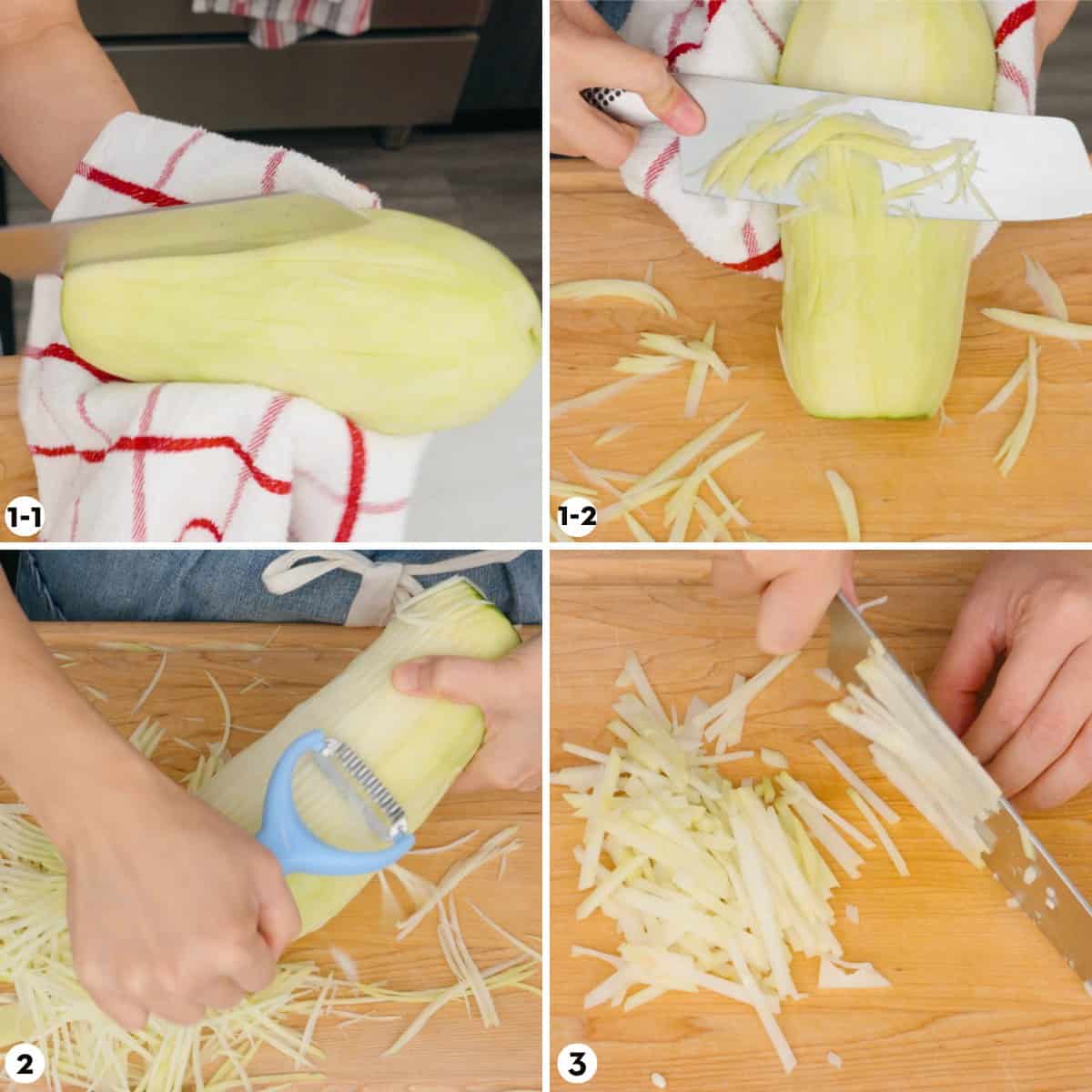
Method 1 - Traditional method: use a chef's knife and chop-chop-chop to make many incisions on the papaya, then use the knife to shave off a layer and you should get beautiful uneven sticks.
Method 2 - Julienne peeler. You can buy a Thai julienne peeler at many Asian stores and online (Kiwi brand). This is what I do at home as it's convenient and fast. Note that the first layer you peel off will be stuck together into a sheet, which you simply have to hand-chop into sticks.
Method 3 - Hand chop. If method 1 is too scary, and you don't have a peeler, you can also just hand chop it! It's slow but it will work. Halve the peeled papaya, scrape off the seeds, and thinly slice into sheets, then chop the sheets into sticks.
How to Make Som Tum in a Mortar & Pestle (traditional method)

- Julienne the papaya and carrot using one of the methods shown above.
- In a mortar and pestle, pound the garlic and chilies until there are no big chunks.
- Add the palm sugar and pound until it is melted into a paste.
- Add the long beans and pound until they are broken.

- Add the tomatoes and pound gently to smash and release the tomato juices, then use a large spoon to scrape the sugar off the bottom of the mortar and let it mix in with the juices.
- Add the lime juice, fish sauce, tamarind, pla ra and MSG (if using), then use a spoon to stir and mix. If using a mortar that's too small for the papaya, transfer to a mixing bowl and continue to step 7 of the hand massage method below.
- Add the julienned papaya and carrots and do the "pound and flip" method - pound a few times, then use the large spoon to flip the papaya to distribute the dressing, then repeat the pounding and flipping a few more rounds until everything is well mixed and the papaya is wilted slightly.
- Plate and garnish with pumpkin seeds. Enjoy!
How to Make Som Tum without a Mortar & Pestle (Hand Massage Method)

- Combine the finely chopped palm sugar, fish sauce and lime juice, then stir until the sugar is mostly dissolved. You'll still have some chunks, but leave them for now.
- Grate or press the garlic into a mixing bowl. Then finely mince the chilies and add them to the bowl as well.
- Use whatever you have to smash the long beans until they're split open, then cut into 2-inch pieces.
- Back to the dressing, stir it well, then use the back of a spoon to mash any remaining sugar lumps which should now easily dissolve. Then add the tamarind, pla ra and MSG (if using).

- Add the long beans and tomatoes, and use a gloved hand to massage the tomatoes to smash and release the juices.
- Add the dressing and mix well.
- Add the papaya and carrots and hand-massage everything until well mixed and the papaya is wilted slightly.
- Plate and garnish with pumpkin seeds. Enjoy!
What is Pla Ra and Where to Find it?
Pla ra (or padaek in Lao) is a fermented fish sauce. But unlike regular fish sauce (nam pla) which is also fermented, it is made from freshwater fish rather than anchovies. Pla ra can be made from a variety of fish, but gourami is a common one. It is thicker, funkier and absolutely packed with umami.
Unlike regular fish sauce which is a commercial product that most people buy, pla ra is an ingredient many people still make still at home, though nowadays you can also buy it. But because it’s historically a homemade item, the flavour of different pla ra varies greatly depending on the recipe used. Some people add various herbs such as lemongrass and makrut lime leaves, others add pineapple juice or even pandan leaves.
Where to buy pla ra? You can find pla ra wherever you find your Thai ingredients. Most of the time it'll be available at Asian grocery stores that carry a good amount of Southeast Asian ingredients. You can also buy it online; here's the brand I use and like and it is a good beginner pla ra that isn't overly funky and is well seasoned (not sponsored, but the company did send the product for me to try).
When shopping, the labelling can often be confusing as it often is labelled simply as "fish sauce." So make sure the liquid inside is cloudy and thick, and the colour can vary from grey to brown. Ingredients should include fish, salt, and some seasonings, and it may also contain herbs, rice bran or some kind of rice product.
Note: The Vietnamese also have a similar product called mắm nêm, which is available at some Asian markets, and you can use it in place of pla ra *in theory.* However, I don't have much experience with it and don't know the extent to which their flavours can vary between brands. So if possible I would stick to Thai brands to ensure the right flavours.
Tip for buying pla ra:
I prefer the more modern Thai brands of pla ra such as Ling Tue Krok (which I use), Zab Mike or E Pim. You can identify these by their more modern branding and a darker brown colour. These are good for pla ra beginners as they are less funky and are well seasoned. The more traditional recipes, which tend to be a lighter grey-ish colour, can be a bit intense if you’re not used to it.
Save this recipe!
Substituting Green Papaya in Som Tum
Green papaya can be hard to find and in some places they can be expensive. But the good news is you can make som tum using a number of vegetables that are firm, crunchy, and have a relatively neutral flavour. Here are some options:
- Kohlrabi. This is probably the best sub in terms of colour, flavour, and ease of use. Simply peel the head and julienne it into sticks. The flavour is similar to broccoli stems.
- Broccoli stems. Now you have a reason to buy broccoli with the giant stem attached! Before you julienne, peel off the tougher skin on the bottom part of the stem, but once you get close to the crown the skin is thin enough that it doesn't need to be peeled.
- Premade broccoli slaw mix. If you can find bagged julienne broccoli slaw mix, which is made from broccoli stems, this is a convenient option.
- Cabbage. The flavour will change, and taste quite distinctly of cabbage, but it is still a delicious salad. I even have a purple cabbage som tum in my cookbook SABAI: Simple Weeknight Thai Recipes.
- Cucumber. In Thailand we make tum tang gwa which is som tum made from cucumber and it's super tasty; and I also have a recipe for a corn and cucumber som tum. If working with an English cucumber, you can remove the seeds to make it less watery, but if using smaller cucumbers the seeds can be left in.
Advance Prep Tips
You can actually make som tum up to an hour ahead of serving time and it'll hold up quite well if you wrap and put it in the fridge. If you want to get ahead of the prep, here are things you can do.
- Julienne the papaya and carrots up to a few days ahead, and keep it in a sealed container in the fridge.
- Make the dressing ahead of time (garlic, chilies, and all the seasonings) and keep in the fridge for up to 2 days. When ready to use, pound the long beans and tomatoes, then add in the dressing and the papaya.
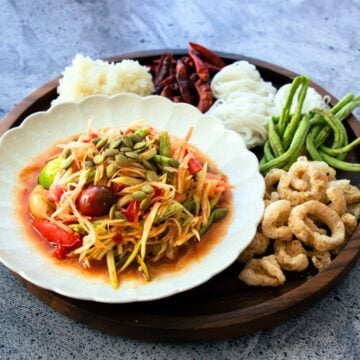
Umami Thai Green Papaya Salad (Som Tum Pla Ra)
Equipment
- mortar and pestle optional
Save this recipe!
Ingredients
- 2 cloves garlic
- 1-3 Thai chilies, to taste, fresh and/or dried
- 1 ½ tablespoon palm sugar, finely chopped, packed
- 2 long beans
- 1 medium tomato, cut into wedges, or sub ½ cup halved cherry tomatoes
- 1 ½ Tablespoons fresh lime juice
- 1 Tablespoons tamarind paste , or sub ½ tablespoon more lime juice
- 1 Tablespoons fish sauce
- 1 Tablespoons pla ra fermented fish sauce, read more about pla ra in the blog post
- ⅛ teaspoon MSG, optional
- 1 ½ cups julienned green papaya
- ⅓ cup julienned carrots
- 2 Tablespoons pumpkin seeds, toasted
- For serving: sticky rice, crispy pork rind, and/or Vietnamese style rice vermicelli
FULL VIDEO TUTORIAL
All my recipes come with step-by-step video tutorials with extra tips not mentioned in the blog post, so make sure you watch the video to ensure success. If you enjoy them, consider subscribing to the YouTube Channel to not miss an episode. Thank you!
Subscribe to my YouTube ChannelInstructions
Mortar and Pestle Method (it’s best to watch the video to see how this works)
- In mortar and pestle, pound the garlic and chilies into a paste. Add the palm sugar and pound until the sugar is dissolved into the paste.2 cloves garlic, 1-3 Thai chilies, 1 ½ tablespoon palm sugar
- Cut the long beans in 2-inch pieces, then add to the mortar and pound until the beans are broken, then add the tomatoes and pound gently to smash and release the tomato juices. Use a large serving spoon to scrape the bottom of the mortar and mix the sugar and garlic with the vegetables.2 long beans, 1 medium tomato
- Add the lime juice, tamarind paste, fish sauce, pla ra and MSG (if using) and use the spoon to mix the dressing together. Taste the dressing and feel free to adjust the seasoning to taste at this point. Note: If your mortar and pestle is too small for the amount of papaya you have, transfer everything into a mixing bowl and continue using the “hand massage” method as described in step 5 in the section below.1 ½ Tablespoons fresh lime juice, 1 Tablespoons tamarind paste, 1 Tablespoons fish sauce, 1 Tablespoons pla ra fermented fish sauce, ⅛ teaspoon MSG
- Add the papaya and carrots to the mortar, pound a few times, then use the spoon to “flip” the papaya and distribute the dressing. Pound a few more times and flip again, then repeat the pound-and-slip a couple more times until the papaya is wilted slightly and the dressing is thoroughly mixed.1 ½ cups julienned green papaya, ⅓ cup julienned carrots
- Plate and top with the pumpkin seeds. Serve with sticky rice and crispy pork rind, if desired.2 Tablespoons pumpkin seeds, For serving: sticky rice, crispy pork rind, and/or Vietnamese style rice vermicelli
Hand Massage Method (It’s best to watch the video to see how this works)
- Chop your palm sugar as finely as possible, then add into a small mixing bowl. Add the fish sauce and lime juice and stir until the sugar is mostly dissolved; there will be some lumps left, leave them for now.1 ½ tablespoon palm sugar, 1 Tablespoons fish sauce, 1 ½ Tablespoons fresh lime juice
- Grate the garlic using a microplane into a large mixing bowl, or press it using a garlic press. Finely mince the chilies and add them to the garlic.2 cloves garlic, 1-3 Thai chilies
- Place the whole long beans on a cutting board, and smash them until they split open using whatever you have that works, such as a wooden spoon or a rolling pin. Cut into 2-inch pieces and add to the garlic bowl, then add the tomatoes.2 long beans
- Back to the dressing, give it a good stir one more time, and if there are any lumps remaining, use the back of a spoon to smash them against the side of the bowl and they should dissolve easily. Add the tamarind, pla ra, and MSG (if using).1 Tablespoons tamarind paste, 1 Tablespoons pla ra fermented fish sauce, ⅛ teaspoon MSG
- Using a gloved hand, massage the beans and tomatoes mixture to smash and release the tomato juices into the bowl, and mix with the garlic and chilies. Add the dressing and use your hand to massage everything together well.
- Add the papaya and carrots to the mixing bowl and hand massage everything to mix and wilt the papaya.1 ½ cups julienned green papaya, ⅓ cup julienned carrots
- Plate and sprinkle with pumpkin seeds and serve with sticky rice and/or crispy pork rind, if desired.2 Tablespoons pumpkin seeds

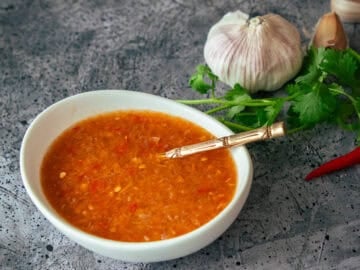
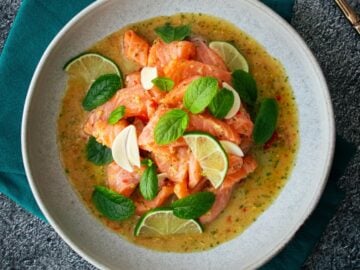
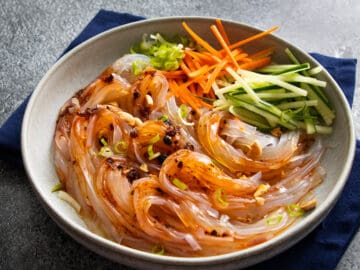
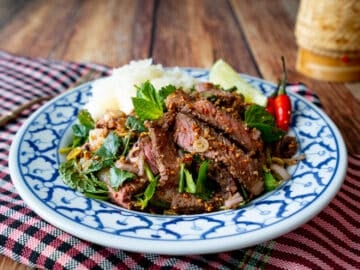
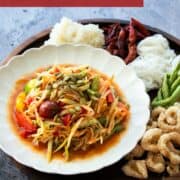
Danny Mitro says
Thank you Pai for this and all your recipes!! I've been cooking Thai food for years, but have avoided making my own Som Tam for a while... (mostly because before I lived in SF and then NYC, where amazing, Lao-style Som Tam was abundant). But now living in Cambridge, I came to the realization that I will have to make my own!
This recipe is good, and I much prefer Lao / Isaan style Som Tam to the regular one. For other Boston-based readers, there's a store / restaurant called BOONNOON Market in Arlington that sells many hard-to-find ingredients, but most importantly: Nam Pla Ra, and *palm sugar in a container that is soft, scoopable, and not dried pucks*.
Some notes from my experience with this recipe:
- I got about 3 cups of shredded papaya from just 1/3 the surface of a green papaya... When you buy a green papaya, be prepared for som tum for days, or have a big family 🙂 As a hungry young man, 3 cups-of-papaya-worth of som tum (double this recipe) was a filling meal along with khao niao sticky rice and some braised tofu
- I'm used to Isaan som tam at Isaan level spiciness. I used 6 chilis (again I made 2x the base recipe), which is the upper bound given here. To me this was a mild som tam, as I believe som tam should be so spicy as to be cerebral. Next time I'll try 10 for the same amount (5 chilies per base recipe). BTW I also freeze my Thai chili peppers which keeps them fresh for long, but maybe reduces some spiciness.
- the recipe didn't say how to replace Chinese long bean with western green beans.. so I eyeballed it. Everything here-- the proportion of papaya vs carrot vs beans, is really up to one. I might reduce the carrot slightly next time.
- I made tamarind paste for this from compacted tamarind. IMO you also really need sticky rice (khao niao) for this! I used Pai's recipe for that-- namely the hot soak + steam. What was funnily convenient is that both the khao niao and the tamarind needed to soak in boiling water for 20 min, so I saved some time.
- I find tomato is quite essential to this and it benefitted from using high-quality, flavor backed ("flavor bomb" etc) cherry tomatoes.
- don't forget to leave lime halves in for pounding
- if I could ever find them, I'd love to augment this with salted crabs, but I may experiment with kabi shrimp paste in the mean time.
Good luck and a merry som tam to all!
Monique says
Optional but strongly recommended is 1/8 teaspoon each of shrimp paste and crab paste.
Change to 8-10 chillies and make 1 teaspoon of MSG mandatory and you’ve got a winner! 🤪
Matt McLean says
This was amazing! Thank you for sharing!
Rick says
Which Pla Ra do you suggest if one likes a bit more funkiness in Som Tum, but doesn't sacrifice the other seasonings?
Pailin Chongchitnant says
Now sure what you mean by "sacrifice other seasonings" but the Pantai one would be the funkier of the two brands shown.
Rick says
On one of the products you suggested, the description used that phrase (Doesn't sacrifice other seasonings). That is why I used it